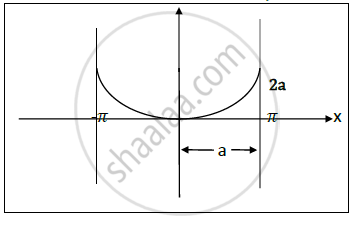Advertisements
Advertisements
प्रश्न
Find the length of cycloid from one cusp to the next , where `x=a(θ + sinθ) , y=a(1-cosθ)`
उत्तर
Given curve :Cycloid `x=a(θ + sinθ) , y=a(1-cosθ)`

The length of given curve is :
`s=int_(θ1)^(θ2) sqrt((dx/(dθ))+(dy/(dθ))^2 dθ)`
`dx/(dθ)=a(1+cosθ) dy/(dθ)=a sin θ`
∴ `(dx/(dθ))^2 +(dy/(dθ))^2=a^2[1+2 cosθ +cos^2 θ+sin^2θ ]`
=`2a^2[1+cosθ]`
= `4a^2 [cos^2 θ/2]`
∴`sqrt((dx/dθ)^2+(dy/(dθ))^2)= 2a cos θ/2`
∴` s= int_-pi^pi 2acos θ/2 dθ`
= `2xxint_0^pi 2 a cos θ/2 dθ`
=` 4a [2 sin θ/2]_0^pi`
∴ `s= 8a`
APPEARS IN
संबंधित प्रश्न
Evaluate `(d^4y)/(dx^4)+2(d^2y)/(dx^2)+y=0`
Evaluate `(2x+1)^2(d^2y)/(dx^2)-2(2x+1)(dy)/(dx)-12y=6x`
A resistance of 100 ohms and inductance of 0.5 henries are connected in series With a battery of 20 volts. Find the current at any instant if the relation between L,R,E is L `(di)/(dt)+Ri=E.`
Solve `(D^3+1)^2y=0`
Solve `(D^3+D^2+D+1)y=sin^2x`
Solve the ODE `(D-1)^2 (D^2+1)^2y=0`
Evaluate `int_0^1 int_0^(x2) y/(ex) dy dx`
Evaluate `int_0^1( x^a-1)/log x dx`
Solve `(D^2-3D+2) y= 2 e^x sin(x/2)`
Using D.U.I.S prove that `int_0^∞ e^-(x^+a^2/x^2) dx=sqrtpi/2 e^(-2a), a> 0`
Solve `(D^2+2)y=e^xcosx+x^2e^(3x)`
Evaluate `int_0^1int_0^( 1-x)1int_0^( 1-x-y) 1/(x+y+z+1)^3 dx dy dz`
Find the mass of the lemniscate 𝒓𝟐=𝒂𝟐𝒄𝒐𝒔 𝟐𝜽 if the density at any point is Proportional to the square of the distance from the pole .
Solve` x^2 (d^3y)/dx^3+3x (d^2y)/dx^2+dy/dx+y/x=4log x`
Solve `(D^2-7D-6)y=(1+x^2)e^(2x)`
Apply Rungee Kutta method of fourth order to find an approximate Value of y when x=0.4 given that `dy/dx=(y-x)/(y+x),y=1` 𝒚=𝟏 𝒘𝒉𝒆𝒏 𝒙=𝟎 Taking h=0.2.
Solve by variation of parameters` ((d^2y)/dx^2+1)y=1/(1+sin x)`
Compute the value of `int _0.2^1.4 (sin x - In x+e^x) ` Trapezoidal Rule (ii) Simpson’s (1/3)rd rule (iii) Simpson’s (3/8)th rule by dividing Into six subintervals.
Evaluate `int_0^(a/sqrt2) int_y^(sqrt(a2-y^2)) log (x^2+y^2) "dxdy by changing to polar Coordinates".`
Evaluate `int int int x^2` `yzdzdydz`over the volume bounded by planes x=0, y=0, z=0 and `x/a+y/b+z/c=1`
Evaluate `int_0^inftye^(x^3)/sqrtx dx`
Find the length of the curve `x=y^3/3+1/(4y)` from `y=1 to y=2`
Solve `(D^2+D)y=e^(4x)`
Evaluate `int_0^1 int_(x^2)^x xy(x+y)dydx.`
Solve `(4x+3y-4)dx+(3x-7y-3)dy=0`
Solve `dy/dx=1+xy` with initial condition `x_0=0,y_0=0.2` By Taylors series method. Find the approximate value of y for x= 0.4(step size = 0.4).
Solve `(d^2y)/dx^2-16y=x^2 e^(3x)+e^(2x)-cos3x+2^x`
Show that `int_0^pi log(1+acos x)/cos x dx=pi sin^-1 a 0 ≤ a ≤1.`
Evaluate `int int int (x+y+z)` `dxdydz ` over the tetrahedron bounded by the planes x = 0, y = 0, z = 0 and x + y + z = 1.
Find the mass of lamina bounded by the curves 𝒚 = 𝒙𝟐 − 𝟑𝒙 and 𝒚 = 𝟐𝒙 if the density of the lamina at any point is given by `24/25 xy`
In a circuit containing inductance L, resistance R, and voltage E, the current i is given by `L (di)/dt+Ri=E`.Find the current i at time t at t = 0 and i = 0 and L, R and E are constants.
